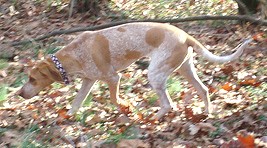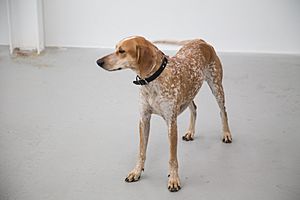American English Coonhound facts for kids

A female redtick English Coonhound
|
|||||||||||||||||||
| Other names | English Coonhound Redtick Coonhound |
||||||||||||||||||
|---|---|---|---|---|---|---|---|---|---|---|---|---|---|---|---|---|---|---|---|
| Origin | United States | ||||||||||||||||||
|
|||||||||||||||||||
| Domestic dog (Canis lupus familiaris) | |||||||||||||||||||
The English Coonhound is a special type of coonhound dog. It is also known as the American English Coonhound or the Redtick Coonhound. This breed first came from the Southern United States. It is related to hunting dogs, especially foxhounds, that settlers brought to America a long time ago in the 1600s and 1700s.
The United Kennel Club (UKC) first recognized this breed in 1905. They called it the English Fox and Coonhound. Later, in 2011, the American Kennel Club (AKC) also fully recognized it as a member of their hound group.
English Coonhounds are medium-sized dogs. Their weight matches their height. Their fur, called a coat, comes in a few main types: redtick, bluetick, and a mix of colors with ticks. These dogs love to chase animals. They are often used for 'coon hunting', and they are very good at making animals climb up trees. English Coonhounds are usually healthy dogs. But, owners should know about a problem called bloat. This can happen because of their large size and deep chest.
Contents
History of the English Coonhound
The English Coonhound's family tree goes back to foxhounds. These dogs were brought to the United States by European settlers in the 1600s and 1700s. This breed shares its history with almost all other coonhounds, except for the Plott Hound.
The English Coonhound developed from dogs called 'Virginia Hounds'. These dogs came from ones brought to the U.S. by people like Robert Brooke, Thomas Walker, and even the first President of the United States, George Washington. The land in America was much rougher than where the dogs came from. So, the breed was specially bred over time to fit these new conditions better. People traditionally used them to hunt raccoons at night and the American red fox during the day. The United Kennel Club (UKC) first recognized them in 1905.
Later, some other coonhound breeds were separated from the English Fox and Coonhound. The Treeing Walker Coonhound became its own breed in 1945. The Bluetick Coonhound was also made into a different breed in 1946.
The English Coonhound was accepted by the American Kennel Club (AKC) in 1995. They called it the American English Coonhound. It was first part of their Foundation Stock Service, which is like a first step for new breeds. Then, in 2010, it moved to a higher class. Finally, on June 30, 2011, the AKC fully recognized it. This made it the 171st breed to be recognized. After this, the American English Coonhound could compete in big dog shows. These included the National Dog Show in 2011 and the Westminster Kennel Club Dog Show in 2012.
What English Coonhounds Look Like
Male English Coonhounds are usually between 22 and 27 inches (56–69 cm) tall at their shoulders. This part is called the withers. Female English Coonhounds are a bit smaller, from 21 to 25 inches (53–64 cm) tall. A Coonhound's weight should be just right for its height.
Unlike other coonhound breeds, English Coonhounds can have many different coat colors. These colors are all fine for the breed's standards. Their fur can be redtick, bluetick, tricolored, or tricolored with ticking. However, red markings are very common. Because of this, "Redtick" is a popular nickname for English Coonhounds.
Some people think that because breeders don't focus too much on color, they can focus on other important traits. These traits include how smart the dog is and how well it can hunt. Even puppies from the same litter can have different colors. This shows that the breed has a lot of different DNA. The English Coonhound's coat is short and feels a bit rough.
English Coonhound Personality
English Coonhounds need to exercise regularly to stay healthy and fit. But when they are not hunting, they are usually calm and relaxed. English Coonhounds often make good family pets.
However, they have a strong urge to chase small animals. So, it's important to train them well if you have small pets at home. They are generally good with children. They are also very loyal dogs and like to make their owners happy. Younger English Coonhounds can be very curious and sometimes destructive. Because of this, it's a good idea to start obedience training early. Giving them lots of attention and exercise is also important. They are known to bark a lot when they are in a cage. So, teaching them to be comfortable in a crate from a young age is also highly recommended.
Like all coonhounds, English Coonhounds are usually friendly and enjoy being around people and other dogs. Being shy or aggressive is not typical for this breed. They can be strong-willed, which means they might be a bit stubborn. This means they need more patience during training than some other dog breeds. English Coonhounds love to find cozy spots and will often try to get on furniture. So, if you don't want dogs on your couch, this might not be the breed for you. They are great family pets because they were bred to get along well in a group. They are also very good hunters. English Coonhounds can also be good watchdogs. Their barks are often long, musical howls and short, loud chops, which are typical for hound dogs.
Hunting with English Coonhounds
This breed is very popular with coon hunters. They have a powerful sense of smell. This helps them track both small and large animals. They can hunt raccoons, cougars, and bears. One type of hunting they are used for is called treeing. In treeing, the dogs chase climbing animals up into trees. Once the animal is in the tree, hunters can find and catch it.
English Coonhounds are known for being good at treeing. But sometimes, they can get so focused that they lose track of their speed. They might even stand their ground, thinking they have chased an animal up a tree, even if they haven't. When they are hunting, they can get a "one-track mind." This means they might ignore everything else, including commands from their owners. When hunting cougars and bears, they can keep these larger animals in place until the hunters arrive. They have become a favorite breed for coon hunting.
Health of English Coonhounds
English Coonhounds can get too hot when they are on coon hunts during the summer in the Southern United States. Dog breeders who focus on this breed check the parent dogs for hip and elbow problems. These problems are called dysplasia. They also check for any eye issues.
Like any dog breed with floppy ears, English Coonhounds should have their ears checked often. This helps make sure there isn't too much wax or dirt buildup. Owners should also learn the signs of bloat. This is a very serious and life-threatening condition. English Coonhounds are more likely to get bloat because of their large size and deep chest.
See also
 In Spanish: American english coonhound para niños
In Spanish: American english coonhound para niños


